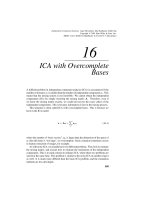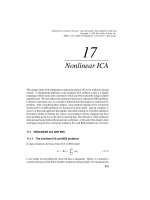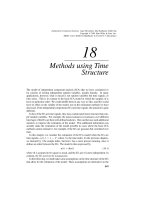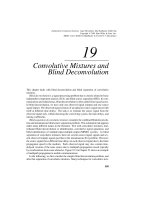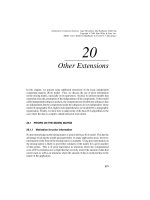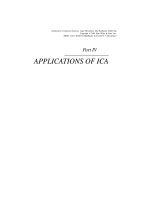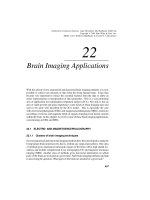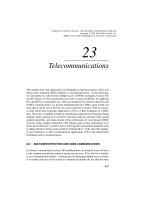Independent component analysis, the validation on volume conductor platform and the application in automatic artifacts removal and source locating of egg signals
Bạn đang xem bản rút gọn của tài liệu. Xem và tải ngay bản đầy đủ của tài liệu tại đây (4.59 MB, 89 trang )
INDEPENDENT COMPONENT ANALYSIS, THE
VALIDATION ON VOLUME CONDUCTOR PLATFORM
AND THE APPLICATION IN AUTOMATIC ARTIFACTS
REMOVAL AND SOURCE LOCATING OF EEG
SIGNALS
CAO CHENG
(B.Eng. USTC)
A THESIS SUBMITTED
FOR THE DEGREE OF MASTER OF ENGINEERING
DEPARTMENT OF MECHANICAL ENGINEERING
&DIVISION OF BIOENGINEERING
NATIONAL UNIVERSITY OF SINGAPORE
2005
ACKNOWLEDGMENTS
First of all, I would like to express my sincere gratitude to my supervisor, Associate
Professor Li Xiaoping from the Department of Mechanical Engineering, NUS, who
has broad knowledge in many fields and has given me invaluable advices and
inspiration in guiding me all the time during the course of this research. His patience,
encouragement and support always give me great motivation and confidence in
conquering the difficulties encountered in the research. His kindness will always be
remembered.
I would also like to thank Associate Professor Einar Wilder-Smith from the
Department of Medicine, NUS and Associate Professor Ong Chong Jin from the
Department of Mechanical Engineering, NUS for their advices and kind helps to this
research.
I am also grateful to my colleagues, Mr. Shen Kaiquan, Mr. Zheng Hui, Mr. Mervyn
Yeo Vee Min, Mr. Ng Wu Chun, Miss Xin Bo, Miss Pang Yuanyuan and Miss Zhou
Wei, for their kind help.
i
TABLE OF CONTENTS
1
INTRODUCTION
1.1 The difficulties in EEG signal processing and the previous resolutions
1
1.2 Research objective
4
2 LITERATURE REVIEW
2.1 Previous work on ECG artifact removal
5
2.2 Previous work on Ocular artifacts
6
2.3 The EEG source reconstruction
12
2.4 The validation of EEG signal processing methods
14
2.5 Mathematical background of independent component analysis
15
3 VOLUME CONDUCTOR PLATFORM FOR VALIDATION OF EEG
SIGNAL PROCESSING ALGORITHMS
3.1 The volume conductor simulation platform
18
3.2 Experiment setup
20
3.3 The results and discussions
21
4
ICA BASED AUTOMATIC ARTIFACT REMOVAL
4.1 Model of ECG artifact
27
4.2 Automatic ECG artifact removal algorithm
28
4.3 Models of ocular artifacts
31
4.4 Automatic Ocular artifacts removal algorithm
40
5 ICA BASED LORETA FOR SPECIFIC LOCATING BRAIN ACTIVITY
SOURCE
5.1 The ICA-LORETA method
46
ii
5.2 Verification by numerical simulation results
48
5.3 Experimental verification using a volume conductor
53
5.4 Extraction of brain activities in response to irregular auditory stimulus
57
6 CONCLUSIONS
66
7 FUTUREWORK
70
REFERENCES
71
LIST OF PUBLISHED WORK IN THE THESIS
78
iii
SUMMARY
Independent Component Analysis (ICA) is a new and powerful blind signal
separation algorithm. It decomposes multi- channel mixed signals into independent
components which are corresponding to original sources of the mixed signals without
any pre-knowledge about the sources and the way of mixture. ICA has been
introduced into (electroencephalo-graph) EEG signal processing recently, but the
application is only in off-line artifacts removal.
In this research, ICA was verified by experiments on a novel volume conductor
platform which has similar electrical characteristic and multi-layer structure to the
human brain. It was shown that ICA can decompose signals mixed on the human
brain with satisfying accuracy. ICA was used to automatically remove ECG and
ocular artifacts online in this research. The independent components corresponding to
ECG and ocular artifacts were automatically identified by specific models and then
removed.
An ICA based Low Resolution Electromagnetic Tomography Method (LORETA)
was also developed in this research for locating the event stimulated brain activities
and spontaneous brain activities from single-trial EEG signal. The EEG signal was
first decomposed by ICA and the independent components corresponding to brain
activities were manually identified by pre-knowledge. The coefficient maps of these
independent components were used as input of the LORETA, and the source
distribution in the brain was obtained. The detailed algorithm was described and
verified by numerical simulation and experiments using a volume conductor platform
as well as functional Magnetic Resonance Image (fMRI) with satisfying accuracy.
iv
NOMENCLATURE
SYMBOLS
T
X
Transpose of matrix X
||w||
Module of vector w
E
Mathematic Expectation
Noise
2
Standard variance
R2
Multiple correlation coefficient
A+
Moore–Penrose pseudoinverse of matrix A
ABBREVIATIONS
std
Standard Deviation
ICA
Independent Component Analysis
EEG
Electroencephaloraph
ME
Magnetoencephalograph
ECG
Electrocardiograph
EOG
Electro-Oculogram
OA
Ocular Artifacts
LORETA
Low Resolution Brain Electromagnetic Tomography
fMRI
functional Magnetic Response Image
v
LIST OF FIGURES
Figure 1.1 EEG signal and artifacts
2
Figure 2.1 Adaptive filter eye artifact canceller
9
Figure 3.1 Models of human brain and watermelon
19
Figure 3.2 Experimental setup for the validation of the volume conductor
brain activity simulation platform
20
Figure 3.3 The location of the sources
23
Figure 3.4 Result of ICA Experiment
25
Figure 3.5 (a) Power spatial maps at three frequency bands. The maps are gray
scaled, dark represents large amplitude. (b)The real source location on the
watermelon
26
Figure 4.1 ICA components and coefficient maps
28
Figure 4.2 The ECG artifact removal
30
Figure 4.3 Original signal, the length is 1024 points
34
Figure 4.4 The performance of wavelet de-noising under different noise
energy level
35
Figure 4.5 Wavelet De-noising for eye blinking
38
Figure 4.6 Wavelet De-noising for eye rolling
39
Figure 4.7 The electrode placement scheme used
40
Figure 4.8 The result for a single epoch of contaminated EEG
43
Figure 5.1 Single Sphere model with two current dipoles D1 and D2
48
Figure 5.2 The waveforms of S1 and S2
48
Figure 5.3 Four channels of the simulated EEG signals, the vertical line
vi
indicates the specific time instant at t=300ms
49
Figure 5.4 The tomography reconstructed by LORETA
49
Figure 5.5 The two independent components separated by ICA. The first one is
source S1 and the second one was source S2
50
Figure 5.6 The coefficients map of the independent components (a) the first
independent component (b) the second independent component
50
Figure 5.7 The tomography reconstructed by LORETA using the coefficient maps (a)
the first independent component (b) the second Independent component
52
Figure 5.8 Devices of watermelon experiment
53
Figure 5.9 Six channels of measured mixed signals on the surface of watermelon, the
sampling rate was 100Hz
54
Figure 5.10 The first four independent components; the sampling rate is 100Hz
54
Figure 5.11 The coefficient maps of the independent components corresponding to
sources. (a) C2 (b) C4
55
Figure 5.12 Raw EEG montage data (experiment pop1).Two vertexes were observed
in Fz-Cz and Cz-Pz channels due to the pop sound stimulus at 6th second.
57
Figure 5.13 Component C6 is the brain response due to the pop sound stimulus
according to Fig 5.12. C3 was the heartbeat artifacts (ECG).
57
Figure 5.14 Raw EEG montage data (experiment pop2). Two vertexes were observed
in Fz-Cz and Cz-Pz channels due to the pop sound stimulus at about 7th second.
58
Figure 5.15 Component C1 was the brain response due to the pop sound stimulus
according to Fig 5.14. C0 was the heartbeat artifacts (ECG)
58
Figure 5.16 Raw EEG montage data (experiment clap1). Two vertexes were observed
in Fz-Cz and Cz-Pz channels due to the clap sound stimulus after 8h second.
59
vii
Figure 5.17 Component C2 was the brain response due to the clap sound stimulus
according to Fig 5.16. C1 was the heartbeat artifacts (ECG)
59
Figure 5.18 Raw EEG montage data (experiment clap2). Two vertexes were observed
in Fz-Cz and Cz-Pz channels due to the clap sound stimulus
60
Figure 5.19 Component C5 was the brain response due to the clap sound stimu lus
according to Fig 5.18. C1 was the heartbeat artifacts (ECG)
60
Figure 5.20 Coefficient maps of ICA components corresponding to response
60
Figure 5.21 Tomography of ICA component C6 in experiment (Pop1) reconstructed
by LORETA
62
Figure 5.21 Tomography of ICA component C1 in experiment (Pop2) reconstructed
by LORETA
62
Figure 5.23 Tomography of ICA component C2 reconstructed by LORETA, in
experiment (Clap1)
63
Figure 5.24 Tomography of ICA component C5 reconstructed by LORETA, in
experiment (Clap2)
64
Figure 5.25 fMRI pictures showing activation regions corresponding to infrequent
target stimulus, where the bright regions were in activation and dark regions were in
deactivation.
64
viii
LIST OF TABLES
Table 4.1 Normalized variance of the ICA components
31
Table 4.2 R 2of the ICA component
43
ix
Chapter 1
INTRODUCTION
1.1The difficulties in EEG signal processing
The electroencephalogram (EEG) was first measured in humans by Hans Berger in
1929. Electrical impulses generated by nerve firings in the brain diffuse through the
head and can be measured by electrodes placed on the scalp. The EEG gives a coarse
view of neural activity and has been used to non-invasively study cognitive processes
and the physiology of the brain. However, the analysis of EEG data and the extraction
of useful information from this data is a d ifficult problem. There are three challenging
problems in the analysis of EEG data: first, the EEG artifacts removal, second the
EEG source reconstructions, third the validation of EEG signal processing methods.
In any actual measurement of signals, the contamination of artifacts and noises is an
avoidless problem especially for the faint signals. Moreover this problem in the
measurement of EEG signal is exacerbated by the introduction of extraneous
biologically generated and externally generated signals into the EEG. These sources
of noises and artifacts include eye blinks, eye movements, heart beat, breathing, and
other muscle activities. Some artifacts, such as eye blinks, produce voltage changes of
much higher amplitude than the endogenous brain activity. In this situation, the data
must be discarded unless the artifacts can be removed from the data. There are various
kinds of algorithms to remove artifacts from EEG. Among them, Independent
Component Analysis (ICA) is the most popular one. But ICA requires manually
selection of independent components corresponding to artifacts and can not be used in
online artifacts removal.
1
(a)
(b)
(c)
(d)
Figure 1.1 EEG signal and artifacts (a) Clean EEG signal (b) Eye blink(c) Eye
movement (d) 50Hz noise
The inverse problem that reconstructs the electric sources in the brain from the
potentials measured on the scalp, generally termed EEG inverse problem has been an
important topic in electrophysiology for a long time. There are two different kinds of
approaches to solve this inverse problem. The first kinds of approaches are based on
dipole model, assuming one or multiple current dipoles to represent the electric
sources, and trying to determine the location or amplitude of these dipoles. The
second kineds of approaches employ distributed source model and estimate the
current distribution in the brain, such as Low Resolution Electromagnetic
Tomography (LORETA. The EEG inverse problem is well known for its
indetermination. Moreover, the volume conductor characteristics of brain makes all of
2
the signals be compounded together, thus the EEG signals are compounded with
external and internal noises and artifacts and uncorrelated brain electric activities. The
external noises and artifacts may invalidate the inverse models if not correctly
removed. The irrelevant brain electric activities make the inverse problem much more
difficult as the number of multiple current dipoles cannot be determined for the dipole
model. Although the LORETA does not need to assume the number of the multiple
current dipoles, it fails to discriminate several different brain electric activities with
nearby active areas, because of its low spatial resolution. Many methods are used in
the pre-processing before solving the inverse problem(Du, Leong,1994; Larsen and
Prinz, 1991; Noda,1989). Digital and analog filters are widely used to remove the
noise and artifacts from the EEG signal. The choice of the parameters of the filters is
based on the known characteristics of EEG signals, artifacts and noise. However, in
real case, this condition can not be always met. The EEG signals of concerned brain
electric activity are often interfered by many unknown or unexpected noise and EEG
signals of irrelevant brain electric activities; moreover in some case, the characteristic
of EEG signals of concerned brain electric activity is unknown neither. A widely used
non parameter method in the research of Event-Related-Potential (ERP) is to filter out
all kinds of noise and uncorrelated brain electric signals by averaging a large number
of time-locked EEG trials. However, in the actual EEG measurement for brain
activities which are spontaneous rather then event-related, such as epilepsy, ERP
cannot be applied and thus the original LORETA can not be used.
For testing some EEG signal processing methods, such as Independent Component
Analysis (ICA) for EEG signal separation, accurate information of the source signals
is necessary. However, EEG signals are complicated and compounded with
3
environmental noise and unexpected artifacts. Moreover because of the volume
conductor characteristic of brain the original signals are unknown. A testing platform
that provides a real experimental environment is necessary and needed.
1.2 Research objectives
The first objective of this research was to develop a novel testing platform which can
be easily acquired and is very similar to the human brain to verify various kinds of
EEG signal processing methods, especially ICA for the decomposition of mixed
signals on the head.
The second objective of this research was to automatically remove two major kinds of
artifacts in EEG signals, ECG and ocular artifacts using ICA.
The third objective of this research was to locate specific brain activity in the brain
from single-trial EEG signals.
4
Chapter 2
LITERITURE REVIEW
2.1 Previous work on ECG artifact removal
The ECG contamination may vary widely in intensity from subject to subject and
even between epochs for a given subject.
Recording techniques such as balancing resistors and reference electrode placement
(montage), help to minimize ECG signal, usually the references are located at the two
earlobes. However, the montage is very sensitive to the dissymmetry of the
distribution of ECG signals on the scalp. Although the strength of ECG signals does
not obviously change across the EEG channels, the remnant of ECG artifact sometime
is considerably large.
Thus techniques to eliminate the ECG signal have been proposed (Barlow and
Dubinsky 1980; Ishiyama el al. 1982; Nakamura and Shibasaki 1987). These
elimination techniques employ a subtraction of the average ECG from the EEG to
construct a clean EEG record. Subtraction methods suffer from both the need to
record a separate ECG channel and the inability to cope with a waxing and waning
ECG contaminant.
The use of robust filters-smothers to eliminate ECG contamination was introduced to
cope with these problems (Larsen and Prinz, 1991). These filter-smoothers do not
require a separate channel of ECG information. In this kind of procedure, ECG
artifacts are considered as additive outliners and the real EEG signal is obtained by a
5
robust A-R model algorithm. However, not only ECG artifacts are additive outliners
in the A-R model, any suddenly appearing peaks may be additive outliners such as
event related potentials (ERP). Thus, this technique can lead over correction. It was
reported that by using Independent Component Analysis (ICA), ECG artifacts can be
successfully removed without any over correction (Wei, Gotman, 2002). But these
algorithms still need visual search for ECG artifact component. Thus they can not be
used in online processing.
2.2 Previous work on Ocular artifacts
Among the many sources of artifacts in EEG studies, eye activity plays a dominant
role. The need of ocular artifacts correction has been shown in the past, and several
methods have been introduced (Brunia et al, 1989 and Jervis et al. 1988).
The simplest and actually most common eye artifacts correction method is rejection.
It is based on discarding portions of EEG that correspond to EOG channel(s)
containing attributes (e.g. amplitude peak, variance and slope) that exceed a
determined criterion threshold (Barlow, 1979 and Verleger, 1993). However, the
rejection method may lead to a significant loss of data, as well as lead to the portions
used not being representative of the study made. This is particularly important when
the brain signals of interest occur near/during strong eye activity, as happens for
example in visual tracking experiments. Another problem associated with the
rejection technique is that one may be unable to identify all eye activity beforehand,
rejecting only the small portion that one can see, and considering artifact-free what is
in fact only artifact-reduced. This may lead to wrong appreciation of the signals
observed.
6
To reduce the presence of eye activity in EEG measurements, the subject is often
asked to avoid blinking, fix the eyes on a target, or restrict the blinking at particular
times. The effectiveness of this eye fixation method can be questionable, especially in
studies of children and of psychiatric or neurological patients, who are not fully cooperative. Thus it may be difficult to collect a sufficient amount of artifact-free data.
Besides, this requirement constitutes a secondary task, leading to reduced amplitudes
in the task of interest (Weerts and Lang, 1973; Verleger, 1991).
A third class of methods, that could be called EOG subtracting methods, bases its
action on the assumption that the measured EEG is a linear combination of true EEG
and ocular artifact. Accepting that one or more EOG derivations well represent all eye
activity, a correction is proposed by subtraction of a regressed portion of this signal
throughout the EEG (Gratton et al., 1983). Time-domain and Frequency-domain
regression methods are popular in EOG artifact removal. Time-domain regression
methods assume that propagation of ocular potentials is volume conducted and
frequency independent and without any time delay. The frequency-domain regression
methods consider the medium through which the EOG activity is conducted to a scalp
location a linear filter. This means for example that some frequencies can be
attenuated more than others. In the time domain the relation between the actual EOG
activity (denoted byVEOG ) and the EOG artifact measured at a given scalp location,
(denoted byVeog ) can be then described as follows:
M
Veogi (t ) VEOGi (t k ) p(k )
k 1
t=1, 2, 3, …, N, k=0, 1,2 ,..., M, M
(2.1)
7
In which i stands for successive trials (time over the experiment) and t for time in
each trial, p(k) is a series of weighted attenuation factors, namely the filter or system
characteristics. The solution of this linear filter implicates that Veog is not only
dependent onVEOG , but also on sample points in the past t - k. This means that the
artifact Veog on the EEG can be deformed but remains linearly related to the EOG.
(Woestenburg, et al 1982). There are disputes about the advantages of the frequencydomain regression over the time-domain regression, as it was reported that in reality
the frequency dependence does not seem to be very pronounced. (Kenemans et al,
1991; Croft and Barry, 2000) However, neither time nor frequency techniques take
into account the propagation of brain signals into recorded EOG. Thus a portion of
relevant EEG signal is always cancelled out along with the EOG artifact. (Jervis et al,
1989).
Berg and Scherg (1994) have introduced another approach for eye artifact correction,
a model based on multiple source eye analysis. In this MSEC (multiple source eye
correction) approach, ocular artifact correction is performed by subtracting source
waveforms defined by the eye activity, rather than proportions of the resulting EOG
signals. The source waveforms are calculated from the EEG signal, together with
topographic estimations of the propagation of eye activity throughout the head. This
method results in considerable eye artifact suppression, but contains some basic
restrictions. First, to perform this type of correction one has to choose a set of
calibrating data containing eye activity that goes well above the background signals
(in this context, the EEG). As stated above, this requirement may be difficult to fulfill.
Second, the technique assumes orthogonality of the source vectors, that are a function
of the location and orientation of each source, and of some head parameters. It is
8
possible that this solution represents a good approximation to the real conditions, but
some further improvements may be necessary, like some independent considerations
between each source and the background EEG. Signal-space projection method
(Huotilainen et al, 1995) is used to identify and remove eye-blink artifacts, with much
success. This approach, like that of Berg and Scherg (1994) requires either a prior
modelling of the production of the artifact, or a considerable amount of data where the
artifact's amplitude is much higher then the EEG or MEG under study. These
requirements, as stated above, may be difficult to fulfill.
The adaptive filters are widely used in EOG artifact removal. One typical application
of adaptive filtering is the interference cancellation by using the available reference to
the interference. An adaptive eye artifact canceller is given in Fig 2.1 Adaptive filters
are especially suitable for non-stationary signals such as the EEG.
Figure 2.1 Adaptive filter eye artifact canceller
The essential assumption for an adaptive interference canceller is that the reference
signal is uncorrelated with the desired signal. Otherwise, over correction will occur.
9
Unfortunately, the undesired correlations often exist due to the dc offset drift in the
reference and the EEG signals. Slow cognitive potentials and head or body movement
artifacts are often responsible for the dc offset drift. Quite a few on-line dc drift
removal algorithms have been proposed in various contexts. All dc detrenders are
essentially high-pass filters. Applying dc drift removal algorithms will inevitably have
effects on the slow cognitive potentials. Since the slow potentials are important to
many EEG studies, a dc detrender can not be used in these situations. Undesired
correlations are the traditional difficulty in the adaptive filtering theory, and there are
no general solutions to the problem. All feasible solutions are problem specific (Du,
Leong and Gevins, 1994).
Time-frequency analysis has been introduced into the artifact removal. Wavelet
based techniques for EOG artifacts removal have been proposed recently (Venkata
Ramanan, 2004). Wavelet transforms are used to analyze time varying, non-stationary
signals, and EEG falls into these category of signals. The ability of wavelet analysis to
accurately decompose EEG into specific time and frequency components leads to
several analysis applications and one among them is denoising. EEG signals have
frequency content that varies as a function of time and recording sites on the scalp.
Hence wavelet techniques can optimize the analysis of such signals by providing
excellent joint time-frequency resolution, which is not possible with Fourier
Transform. In contrast to Short Time Fourier Transform (STFT), wavelet transform
adapts the window size according to the frequency. . In EEG data sets, there may be
some specific components or events that may help the clinicians in diagnosis. They
may tend to be transient (localized in time), prominent over certain scalp regions
(localized in space) and restricted to certain ranges of temporal and spatial frequencies
10
(localized in scale). Wavelet analysis provides flexible control over the resolution
with which neuroelectric components and events are localized in time, space, and
scale. However the choice of value of wavelet coefficients threshold for de-noising is
quite experiential. The general assumption of wavelet based de-nosing techniques is
that the artifacts such as (heartbeat and EOG artifacts) are much stronger (10-100
times) than EEG signal. So the EEG signal can be considered as “noise” compared
with artifacts and can be filtered out by setting a cut-off threshold from the wavelet
coefficients of the recorded signal and then get the “pure” artifacts. The reconstructed
EEG signals are obtained by subtracting the pure artifacts from the recoded signals.
However, this assumption is not always true as the EOG artifacts decrease rapidly
when propagating from forehead to occipital area. In the occipital channels the EOG
artifacts are comparable with the EEG signal. In these channels, the EEG signal can
not be considered as noise-like compared to EOG signal.
Inspired by the non-linearity of signal processing in the human brain, Rao and Reddy
(1995) introduced a non-linear on-line method to enhance the EEG signals in the
presence of ocular artifacts. Their method, using the recursive least squares based on
the second-order Volterra filter, has shown good performance, but its non-linearity is
still too limited, as it stops at second order statistics (variances and covariances).
Mathematical and experimental work proves that higher order statistics may be
needed to separate independent signals (Karhunen, 1996; Hyvarinen and Oja, 1997;
Karhunen et al.,1997 ). Makeig et al. (1996) have recently introduced a comparable
application of the independent component analysis (ICA) to EEG signals. Using ICA
to separate brain activity from eye artifacts, based on the assumption that the brain
and eye activities are anatomically and physiologically separate processes, and that
11
their independence is reflected in the statistical relation between the electrical signals
generated by those processes. Even if no limitation seems to exist on the type of
artifact that can be extracted, the fact that the ocular ones are the most representative
justify their choice as illustration of the method. Like the application in ECG artifact
removal, this method still needs visual search for EOG artifact component.
2.3 The EEG source reconstruction
The inverse problem of EEG is defined as the estimation of the distribution of
electromotive force (EMF) in the brain from EEG by mathematical manipulations. As
is well known, the solution to the inverse problem is not unique, since there exist
silent EMF distributions that do not generate any electric at all outside the closed
surface involving them (Rush, 1975). This difficulty is usually circumvented by
making use of some simplified models for the EMFs such as multipoles, moving
dipoles, multiple fixed dipoles, distributed source distribution and so on: the
parameters of these models can be determined uniquely by fitting the forward solution
to the measured EEG.
Depending on the models for the EMF distribution, various methods have been
proposed to solve the inverse problems: equivalent dipole method (Musha and
Okamoto, 1999), BESA (Scherg and Picton, 1991), MUSIC (Mosher and Leahy,
1998), LORETA (Pascual-Marqui et al., 1994) to name a few of the major ones. The
equivalent dipole method is based on the moving dipole model. In this method EMF
sources in the brain are approximated by a small number of current dipoles, and their
locations and moments are estimated by fitting the EEG generated by them to the
measured ones. In BESA (Brain Electric Source Analysis) and MUSIC (Multiple
12
Signal Classification), the locations of dipoles are assumed to be fixed during some
time interval, and they are determined from the potential distributions measured
repeatedly during that time interval. The LORETA source estimation approach is a
kind of discrete and distributed source estimation. The source region is divided into
grids. As the grids are dense enough, the dipole source can be considered to locate on
each of the grid points. For a given orthogonal coordinate, the dipole sources with
different strengths and directions can be expressed as the linear combination of the
unit dipoles along x, y, z directions. N observing points were put on the scalp outside
the source region. The relationship between the strength of the unit dipoles along the
directions at each grid point and the potential at the observing points can be written as
v = KJ
(2.2)
where J = [ j1T , j2T ,... jM T ]T is a 3M-vector comprised of the current densities ji (3vector) at M points with known locations within the brain volume; v is the N –vector
comprised of measurements; K is the transfer matrix with N 3M ranks. The transfer
matrix of can be calculated by the numerical method, such as the finite-element
method, however, the analytical expression is available for the sphere model of brain.
The number of grids is usually greater than that of the observing points, that is 3M>N,
so this simultaneous equation system is an underdetermined system, and it does not
have a unique solution. The LORETA source estimation approach is to find out
min BWJ
2
, under constraint: v = KJ
(2.3)
J
13
where B is the discrete Laplacian operator N 3M matrix. W is a diagonal matrix with,
wii k i
1
where k i is the ith column of K. If W is nonsingular, the unique solution of
equ.2.3 is
J W ( KW ) v
(2.4)
where A+ denotes the Moore–Penrose pseudoinverse of matrix. Thus a low resolution
tomography is generated by this algorithm.
LORETA is famous for the generation the "smoothest" solution with the effect of
depth properly considered. The distributed source model and the "smoothest" solution
of LORETA have been adopted by many researchers because it is more
physiologically realistic than the dipole model. The dipole model and the distributed
source model are all based on the spatial distribution of the EEG potential, while the
temporal characteristics of EEG signals are not fully considered. Moreover, all
previous methods for EEG inverse problem are actually only available for event
related potential (ERP) which is acquired from average of hundreds of time-locked
EEG trials, and not available for single trial EEG. So they can not be used to locate
the source of specific spontaneous brain activity.
2.4 The validation of EEG signal processing methods
There are two ways to validation of EEG signal processing methods.The first method
is numeric simulation using simplif ied head models. Although several sophisticated
head models have been developed which provide realistic head shapes (Cuffin, 1995),
most commonly used models are multi-shell spherical models due to their simplicity
in theoretical treatment and computation. These models consist of three to four
concentric shells with different conductivity values representing the brain, skull,
14
cerebrospinal fluid (optional), and scalp (Rush and Driscoll, 1968; Cuffin and Cohen,
1979; Mingui, 1997; Pascual-Marqui, 1999). The choice of the head model is crucial
as more simplified model requires less computation but loses more similarity to the
real human head, while more sophisticated head models usually require large
computation. Moreover, as the simulation methods only consider ideal situation in
which the data is clean without any noise and artifacts, the ability of coping with
noises and artifacts can not be tested by the numeric simulation way.
The second one is using implanted dipoles in epileptic patients undergoing
presurgical intracerebral recordings (Cuffin et al 1991). The current dipoles are
created by passing a weak (subthreshold) current through intracerebral electrodes
implanted in the brains of epileptic patients for seizure monitoring. The locations of
these dipoles are accurately known from roentgenographs. This method can provide
totally realistic testing environment and most reliable results. However, implanting
electrodes in the brain needs proper subjects and specific surgery, which are
extremely inconvenient and not available for ordinary researchers.
2.5 Mathematical Background of Independent Component Analysis
Independent component analysis is a novel statistical technique which was developed
in context with blind source separation (Jutten and Herault, 1991; Comon, 1994), in
which case the original independent sources are assumed to be unknown, and yet to
be separated from their weighted mixtures.
2.5.1 The Model
15

